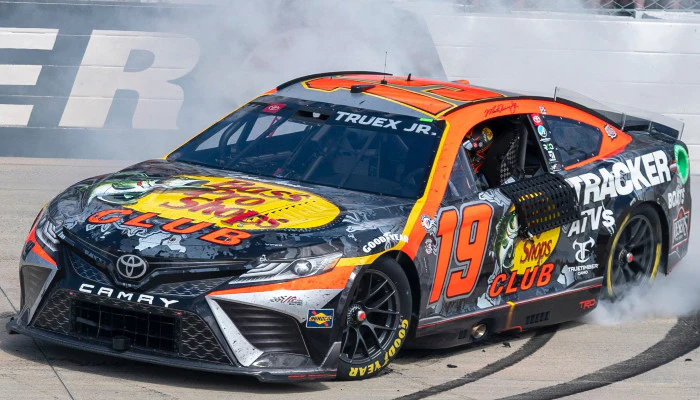We all may have heard of driver points and the driver standings when it comes to the NASCAR Cup Series. These are easy-to-digest stats that show where drivers rate in the chase for the NASCAR Cup Series Championship. These stats are based on the number of wins and playoff points a driver has accumulated during the season while in competition for the Cup Series Championship. Did you know that there may be an even better statistic to show you how a driver rates against other drivers?
This is a statistic that many NASCAR fans may not know about and it is called the NASCAR driver rating. This is a combination of statistics that the NASCAR sanctioning body uses to rate drivers during a race, which was first implemented in 2005. The beauty of the NASCAR driver rating is that it pulls in data from several areas to help NASCAR rank the drivers on a weekly and season-long basis. Here’s how the NASCAR driver rating is explained!
How Does NASCAR’s Driver Rating Work?
The NASCAR driver rating is a combination statistic that pulls from several basic stats that are accumulated. It is not just a statistic based on how a driver finishes at the end of an event, but is designed to consider several factors. Here’s why this is important. A driver may lead a race for much of the event only to be taken out of a win due to a wreck or equipment failure.
Or a driver may be stuck in the middle of the pack during a race only to find themselves in a great position for the final few laps. NASCAR, as a sanctioning body, realized that this would not give an accurate picture of how a driver performed during a race. This is why NASCAR created a combination of statistics to more accurately portray how a driver performs overall despite how they finish at the end of a race.
How Do the NASCAR Playoffs Work
How to Calculate NASCAR Driver Rating
The NASCAR driver rating is calculated by combining several statistics starting with wins and the finishing positions of a driver. Then comes the addition of the driver’s number of top-15 finishes and the average running position, but only while racing on the lead lap. Then there are even more data points added into the equation. Here are all of the statistics that make up the NASCAR driver rating.
Number of wins.
Number of top-15 finishes.
Average running position on the lead lap.
Average speed under green flag racing.
Fastest lap time.
Most laps as the leader.
Lead-lap finish.
NASCAR Driver ratings are calculated during the entire season and per race. A perfect rating in a single race is 150.0.
How Bettors Can Utilize NASCAR Driver Rating
The driver rating stat is an elite one. Only a handful of drivers score a perfect 150 during a career. As you can probably guess, the names of the drivers that have done so are an elite group. Since the rating formula was only initiated in 2005, it’s easy to go back and see who’s achieved the highest ranking. Does this apply to bettors placing wagers? Yes, it does – check out some of the past NASCAR Cup Series Champions that have achieved perfect 150 driver ratings.
Kevin Harvick – 2006 at Phoenix Raceway, 2014 at Phoenix Raceway, 2015 at Phoenix Raceway, 2018 at Las Vegas Motor Speedway and 2019 at Indianapolis Motor Speedway. Harvick was the Cup Series Champion in 2014 and the first driver to achieve a perfect 150 rating five times since the statistic was put into use in 2005.
Jimmie Johnson – 2008 at Auto Club Speedway, 2009 at Dover International Speedway, 2012 at Indianapolis Motor Speedway and 2013 at Texas Motor Speedway. Jimmie Johnson won the Cup Championship seven times; 2006, 2007, 2008, 2009, 2010, 2013, and 2016.
Kurt Busch – 2005 at Phoenix Raceway, 2005 at Pocono Raceway, 2007 at Pocono Raceway, 2009 at Atlanta Motor Speedway. Kurt Busch won the Cup Series Championship in 2004.
Kyle Busch – 2016 at Indianapolis Motor Speedway, 2018 at Charlotte Motor Speedway. The Younger of the Busch brothers won the Cup Series title in 2015 and 2019.
Tony Stewart – 2005 at Watkins Glen International. Stewart was crowned the Cup Series Champion three times; 2002, 2005, and 2011.
Martin Truex Jr. – 2016 at Charlotte Motor Speedway, 2018 at Auto Club Speedway and 2021 at Darlington Raceway. Truex won his Cup Series title in 2017.
Brad Keselowski – 2014 at Kentucky Speedway and 2019 at Martinsville Speedway. Keselowski took home the Cup Series title in 2012.
Kyle Larson – 2021 at Texas Motor Speedway. Larson won the Cup Series Championship 2021.
Three drivers have achieved a perfect NASCAR Driver Rating that have not won a Cup Series Championship. They are Clint Bowyer at New Hampshire Motor Speedway in 2007, Denny Hamlin in at Richmond Raceway in 2007 and Carl Edwards at Homestead-Miami Speedway in 2010.
As you can see, the drivers named above are a very elite group! So it’s easy to see how you can use the NASCAR driver rating to benefit your choices when wagering. One of the best ways to apply this knowledge is to check out the driver rating for your selected driver at the track you are placing a wager on. Depending on the website, you can find the data broken down into a per race and track basis complete with how their rating changed during that race.
Putting NASCAR Driver Ratings to Use
NASCAR driver ratings are a great combination of data points that rate how a driver has done not only on a track, but also during the entirety of the season. While some people, like me, love diving into several stats while doing research – others may not have the time or love of random stats.
Thankfully, NASCAR has taken the time to do all of the research for you. I will always suggest looking over several factors when making any wagering selection. However, if you need a quick idea about how a driver is doing on the year and how they performed at a certain track – then the NASCAR driver rating is a perfect statistic to start with.
 ES
ES 











